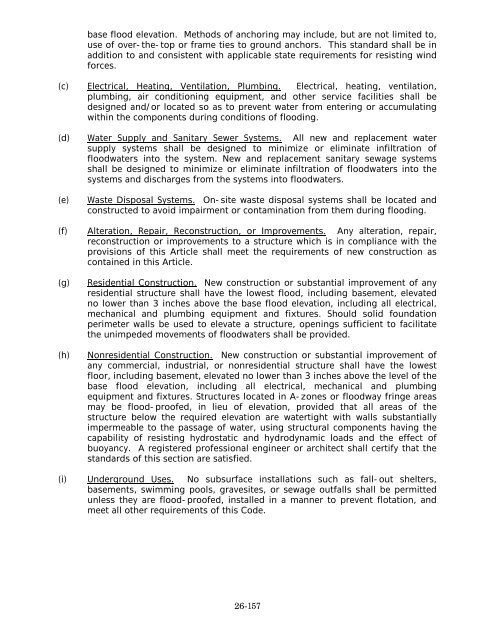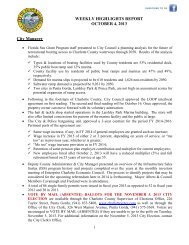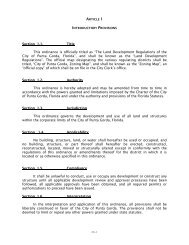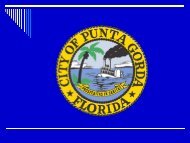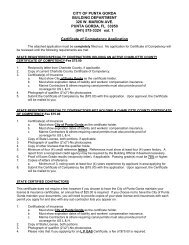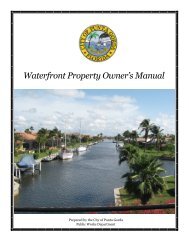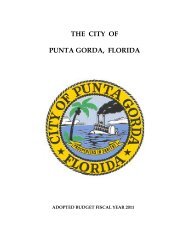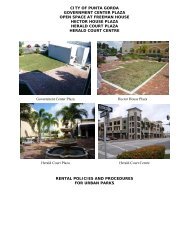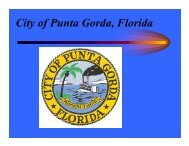Chapter 26 - City of Punta Gorda
Chapter 26 - City of Punta Gorda
Chapter 26 - City of Punta Gorda
Create successful ePaper yourself
Turn your PDF publications into a flip-book with our unique Google optimized e-Paper software.
ase flood elevation. Methods <strong>of</strong> anchoring may include, but are not limited to,<br />
use <strong>of</strong> over-the-top or frame ties to ground anchors. This standard shall be in<br />
addition to and consistent with applicable state requirements for resisting wind<br />
forces.<br />
(c) Electrical, Heating, Ventilation, Plumbing. Electrical, heating, ventilation,<br />
plumbing, air conditioning equipment, and other service facilities shall be<br />
designed and/or located so as to prevent water from entering or accumulating<br />
within the components during conditions <strong>of</strong> flooding.<br />
(d) Water Supply and Sanitary Sewer Systems. All new and replacement water<br />
supply systems shall be designed to minimize or eliminate infiltration <strong>of</strong><br />
floodwaters into the system. New and replacement sanitary sewage systems<br />
shall be designed to minimize or eliminate infiltration <strong>of</strong> floodwaters into the<br />
systems and discharges from the systems into floodwaters.<br />
(e) Waste Disposal Systems. On-site waste disposal systems shall be located and<br />
constructed to avoid impairment or contamination from them during flooding.<br />
(f) Alteration, Repair, Reconstruction, or Improvements. Any alteration, repair,<br />
reconstruction or improvements to a structure which is in compliance with the<br />
provisions <strong>of</strong> this Article shall meet the requirements <strong>of</strong> new construction as<br />
contained in this Article.<br />
(g) Residential Construction. New construction or substantial improvement <strong>of</strong> any<br />
residential structure shall have the lowest flood, including basement, elevated<br />
no lower than 3 inches above the base flood elevation, including all electrical,<br />
mechanical and plumbing equipment and fixtures. Should solid foundation<br />
perimeter walls be used to elevate a structure, openings sufficient to facilitate<br />
the unimpeded movements <strong>of</strong> floodwaters shall be provided.<br />
(h) Nonresidential Construction. New construction or substantial improvement <strong>of</strong><br />
any commercial, industrial, or nonresidential structure shall have the lowest<br />
floor, including basement, elevated no lower than 3 inches above the level <strong>of</strong> the<br />
base flood elevation, including all electrical, mechanical and plumbing<br />
equipment and fixtures. Structures located in A-zones or floodway fringe areas<br />
may be flood-pro<strong>of</strong>ed, in lieu <strong>of</strong> elevation, provided that all areas <strong>of</strong> the<br />
structure below the required elevation are watertight with walls substantially<br />
impermeable to the passage <strong>of</strong> water, using structural components having the<br />
capability <strong>of</strong> resisting hydrostatic and hydrodynamic loads and the effect <strong>of</strong><br />
buoyancy. A registered pr<strong>of</strong>essional engineer or architect shall certify that the<br />
standards <strong>of</strong> this section are satisfied.<br />
(i) Underground Uses. No subsurface installations such as fall-out shelters,<br />
basements, swimming pools, gravesites, or sewage outfalls shall be permitted<br />
unless they are flood-pro<strong>of</strong>ed, installed in a manner to prevent flotation, and<br />
meet all other requirements <strong>of</strong> this Code.<br />
<strong>26</strong>-157


